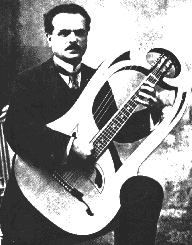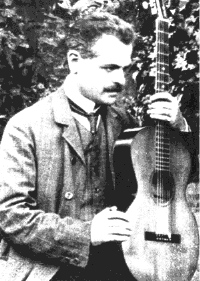

Luigi Mozzani was born in Faenza (in the old Romagna region) on 9 March 1869, in an extremely poor family native to Ancona. His father was a cobbler and his mother a weaver. The family's state of poverty induced the young Luigi to abandon his studies after the very first year, when he was six. A baker who played the trumpet taught Luigi his first musical lessons [1]. Soon Luigi was able to obtain a job in the town band of Faenza, as a clarinetist.
The story goes that one summer evening Luigi heard a guitar for the first time. He was so impressed that he strongly desired to learn how to play it. His first borrowed guitar was very old and rickety, but Luigi was able to repair it. So he started studying on it, following the methods in fashion at that time (Carulli, Giuliani) [2].
In the meantime he also studied oboe, hoping to find employment. He eventually studied at the Conservatory of Bologna beginnig when he was 22, receiving his diploma in oboe with full honors. He toured extensively already in those years in Africa, Japan and in other European countries, including Russia where he was very successful [3]. Then he lived in America for two years (1894-1896), as oboist in the New York Philharmonic. In New York he published the three volumes of his "Studies for guitar" in 1896, published by F.A. Mills. These studies are renowned as "Mozzani's Method", but they are really a collection of exercises, chords, arpeggios and scales aimed at advanced players. Each of them develops an instrumental technique focused on the guitar's tonal and harmonic extensions.
At the end of nineteenth century, shortly after a lucky European tournée, Luigi Mozzani established himself in Paris where he made contact with the greatest active guitarists at that time: Alfredo Cottin, Gélas and Miguel Llobet. In France he wrote "8 Pieces for solo guitar" that were published after his death by Bèrben (1963). During his stay in Paris, Mozzani became interested in the making of the guitar, too. He then returned to Italy, staying first in Faenza, where he established his first workshop for guitar making. In 1899 he published various pieces for guitar among which the famous "Preghiera".
Afterwards he took up residence in Bologna, nearby the poet Giosuè Carducci's house. There he prepared a model of guitar after Guadagnini.
Mozzani continued to deal with guitar making without abandoning concertizing. He toured in England, where he lived for around six months, in France, in Germany and in Austria [4]. In the 1906 he presented anonymously a Serenata at the musical contest of the Italian magazine Il Plettro, organized by Mr Alessandro Vizzari (guitarist and publisher). This composition won the first prize with golden medal and then it was published with its caption: the notorious Feste Lariane, air with variations. This piece, despite being known today as attributed to Manuel Ferrer [see [5], [6]], in effect gave him a great reputation, especially abroad.
Between 1905 and 1908 Mozzani toured
especially in Germany and Austria. He stayed in Munich, hosted by Mr Buek,
president of a guitar society. There he visited a collection of harp
guitars, or guitar-lyras, built many years before by Austro-German
makers (the Viennese Knaffl and Schenck, Raab, etc.) and improved subsequently
by the maker Friederich Schenck. Mozzani was keen on these instruments,
especially for their construction and also for the use of the sub-bass
strings and for the technical possibilities. He was also very fond of the
"Wappen" guitars (see e.g. Der Gitarrenfreund Munich 1931).
During the first decade of the 1900s, Mozzani settled finally in Cento, in the province of Ferrara. There he made various models of guitar with the cooperation of local craftsmen. He alternated between the craft, the concerts and the teaching. He tried to change the model of guitar-lyras conceiving a device able to regulate the angle of the neck through a system of screws. This innovative solution was patented in 1912.
In the 1908 he published in Berlin the virtuosic "Colpo di vento" (Wind Gust), "Mazurka" and "Valzer lento". Then he had to leave Germany, because of the political turmoil.
Between 1910 and 1924 he made many bowed instruments and all the types of string instruments necessary for constituting a plectrum orchestra. He worked in close collaboration with all the plectrum orchestras present in Italy. In his school there was the ypoung and skillful Mario Maccaferri, who wwas to cleverly continue the work of concertizing, guitarmaking and commerce. In 1914 Mozzani started again his concert activity, that brought him to almost all Italian cities. His daughter Juliet's illness (cerebro-spinal meningitis) and her death in 1916, shocked Luigi who was devastated and decided to abandon the concert activity. And so he did for the next 15 years.
However Mozzani did not give up keeping his hands busy: he designed and manufactured a wooden "counterbore" with metallic parts for the left hand fingers and a pocket stringed tablet of hollow wood for training the right hand. He made also a portable folding travel guitar .
In 1927, after an agreement with the municipality of Cento, his laboratory was transformed into the "Italian School of Lutherie Luigi Mozzani" and was later transferred to Bologna. One could enter this school only through a contest.
After 1934 however the school was closed for political reasons. Luigi Mozzani would again take up his craft in a workshop at first in Cento and finally in Rovereto. His guitars were sold almost worldwide. Until 1939 Luigi kept on performing publicly. He recorded three 78 rpm albums with much of his music that are still preserved. Mozzani was only able to open a school again in 1942 in Rovereto. There he died the subsequent year, in 1943.
The last Mozzani school was still active until 1947 under the guidance of his wife Alfonsina and a trustworthy instructor, when the municipality decided to stop their activity. Most of the materials were resold or dispersed, the heirs drew up a contract with the Farfisa musical house, allowing the making of guitars with the brandname "Mozzani." Many instruments made by Mozzani, as well as his manuscripts, some still unpublished, containing his experiments are at times exhibited in local expositions.
Angelo Gilardino in his Manual (a volume of the history of modern and contemporary guitar), [7]):
As a whole, Mozzani's composition work, being in no way inferior to the Tárrega's one, reflects a particular moment of Italian music at the end of nineteenth century, of which it offers an agreeable guitar synthesis, nothing like an amateurish one at all: in him also you feel the aspect of the rebirth, a jointly humble and rigorous presentiment, like a gasp that, not being able to define itself in one's conscience, is expressed however in a sweet and at the same time severe attitude. Here is the rustic Italy of the popular singing, the bourgeois Italy of the Veristic epoch and of the "Ideal."
copyright © 1998-2000 Seicorde.org - wherever they are?